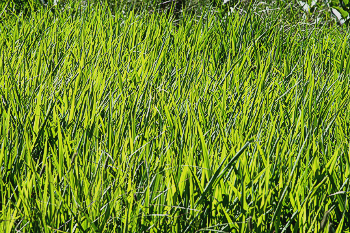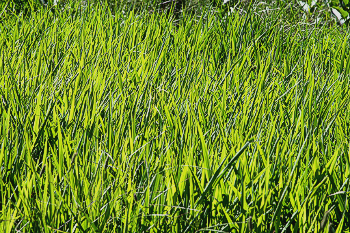The following essay was written by Paul Tukey, founder of SafeLawns.org and the author of The Organic Lawn Care Manual.
 The perfect lawn doesn’t require gasoline or synthetic fertilizer.Muffet via FlickrGrass Happens.
The perfect lawn doesn’t require gasoline or synthetic fertilizer.Muffet via FlickrGrass Happens.
As a former lawn care professional, I couldn’t help but laugh out loud when I first saw that bumper sticker on a passing pickup truck full of lawn mowers. Insert any word of your choice to replace grass – Death, Tax, Greed, Hunger, you name it – and you will be commemorating the same fundamental inevitability.
Call it twisted landscape humor, an inside joke for anyone who has spent part of his or her life trying to keep landscapes under control. Including all the various species, grasses are some of the most prolific and resilient flora on the planet. Virtually anywhere you live, chances are you will have some spiked, green plants sprouting on your property, whether or not you want them there.
Lawns have always been another matter entirely. They haven’t just happened, but have instead necessitated all manner of conflict resolution. From the earliest days of civilization, an area of short-cropped vegetation required decisive action to meet the definition of a lawn. At first, goats and sheep were put out to forage plants to the ground; in the 1700s, peasants and slaves wielded machetes and scythes.
Almost two centuries ago tinkerers and machinists in Europe and North America began competing relentlessly to be first to create devices that would make the practice of mowing more accessible to everyman. By 1871, Elwood McGuire won Round 1. The resident of Richmond, Indiana, developed a cutting machine that could be mass-produced and, in the process, unleashed a latent lawn lust that seemed to have been secretly encoded in America’s collective DNA. By the beginning of the 20th century, inventors had created a steam-powered lawn mower and then in the 1950s came the machine that almost single-handedly painted the American Dream: the gas-powered rotary mower.
“The appearance of a lawn bespeaks the personal values of the resident,” declared a trade association known as The Lawn Institute in 1953, commenting on a post-World War II boom in mower purchases. “Some feel that a person who keeps the lawn perfectly clipped is a person who can be trusted.”
We may have moved on from our grandfather’s politics, but haven’t budged a bit from our collective definition of American success: Nice home, shiny car, big green lawn. According to NASA satellite images, the United States is blanketed in approximately 50 million acres of turf, with several hundred thousand acres of grass being added each year.
All that mowing, trimming and blowing contributes up to 10 percent of our nation’s air pollution every summer in the form of hydrocarbons (a major component of smog), particulate matter (which damages respiratory systems), carbon monoxide (a poisonous gas) and carbon dioxide (a greenhouse gas that contributes to global warming). Gas-powered lawn mowers, blowers and trimmers are 10 to 30 times more polluting than combustion-engine automobiles and, well, we all know where the car industry is headed.
It should come as no surprise, then, that today’s Elwood McGuires are waging a new race: to develop kinder, gentler technologies for taming America’s little green patches of paradise. Like it or not, the grass is still growing. More and more folks are mowing it with machines that are human- or electricity-powered. A new campaign co-promoted by the non-profit SafeLawns.org of Washington, D.C., and the for-profit Black & Decker company of Maryland challenges homeowners everywhere to “Get Your Grass Off Gas.”
“By choosing electric or cordless outdoor power equipment, you’re not only helping the environment, your neighborhood and your family, but you are also freeing yourself of the mess and hassles associated with gas-powered products,” said DeAnn Romjue, director for Black & Decker’s Outdoor Products division.
The statistics in support of the change are staggering. A traditional mower running for 45 minutes consumes about 50,000 BTUs of energy in the form of gasoline. An electric mower doing the same job requires just 2,500 BTUs in form of kilowatts. Some estimates put the electric mowers at 90 percent less polluting than gas models and the cost savings per season is ample. About $5 of electricity will run your electric mower for the whole season on a third-acre lawn that would otherwise require about $40 to $50 in gas and oil.
After four years of kicking the gas habit in my own yard, however, my favorite aspects of the switch to an electric mower have nothing to do with money. The machine always starts, it’s far quieter and my clothes don’t smell like fumes when I’m done. The process, believe it or not, has become kind of fun.
Grass, after all, may be inevitable. The agony of caring for it shouldn’t have to be.
—



